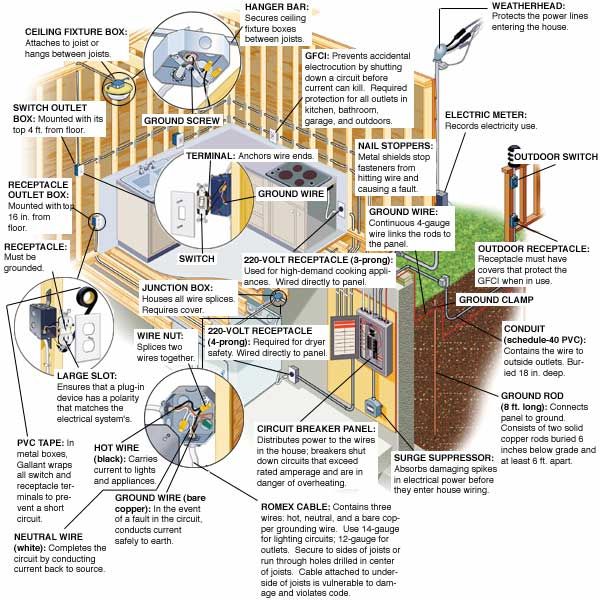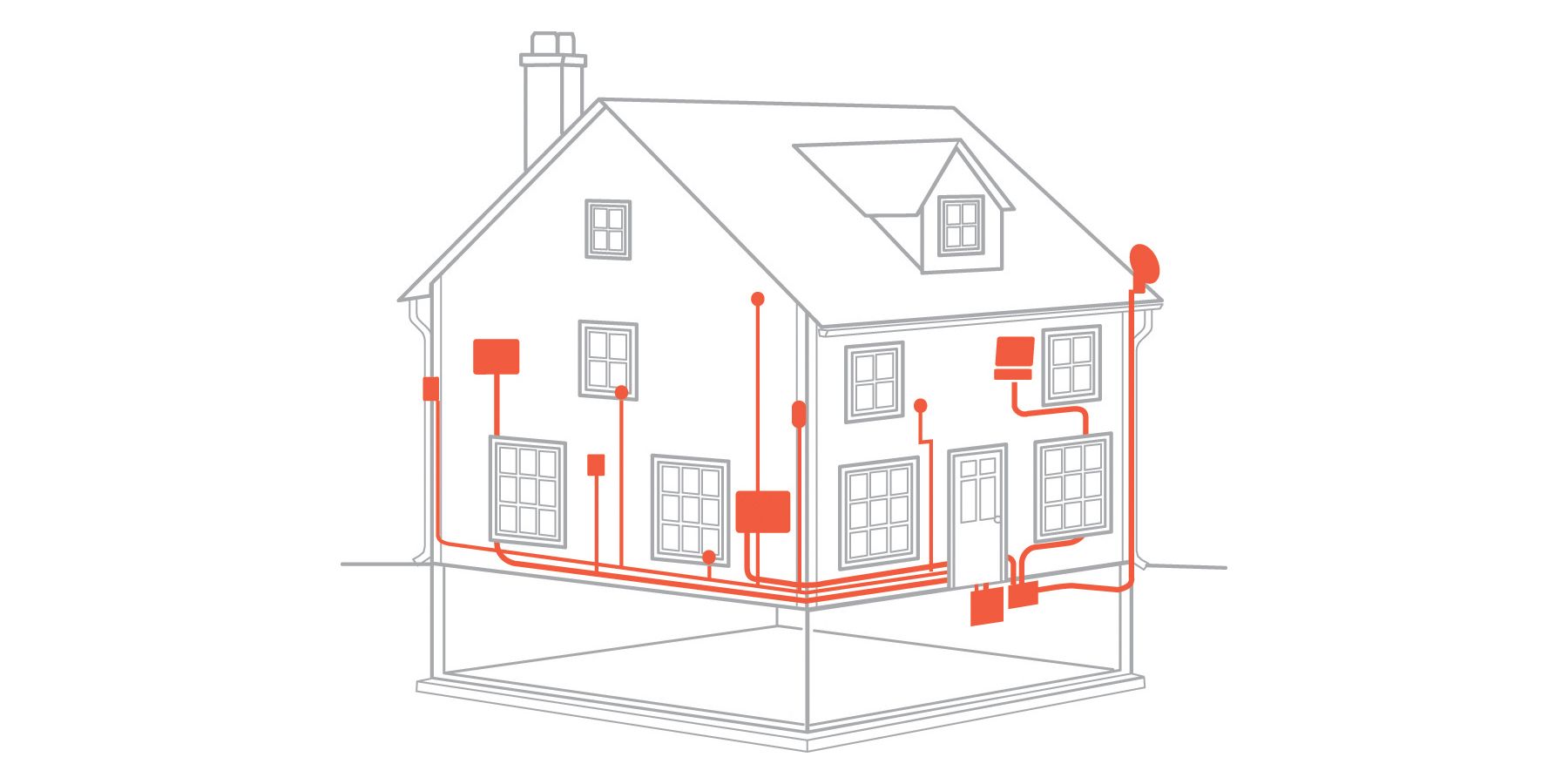Electrical wiring is the backbone of any modern home, powering our lights, appliances, and devices. It’s important to understand the basics of electrical systems if you’re building a new house or renovating an existing one. Our guide will walk you through the essentials of home electrical wiring, from planning and installation to safety considerations and future-proofing your system.
The Basics of Home Electrical Systems
A home electrical system is a complex network that distributes power throughout your house. At its core, electricity enters your home through the main service panel, where it’s divided into circuits that power different areas and appliances. These circuits are protected by circuit breakers or fuses, which prevent overloads and short circuits.
Essential Components for Electrical Wiring
The image below breaks down the major components of electrical wiring within your home.

Several key components work together to create a safe and efficient electrical system. Let’s explore the main elements of a home’s electrical infrastructure.
Main Service Panel
The main service panel, also known as the breaker box, is the heart of your home’s electrical system. It receives power from the utility company and distributes it to various circuits throughout your house.
Circuit Breakers and Fuses
Circuit breakers and fuses are safety devices that protect your electrical system from overloads and short circuits. They automatically cut off power when they detect an issue, preventing potential fires or damage to your appliances. Modern homes typically use circuit breakers, which can be easily reset, while older homes may still have fuse boxes.
Wires and Cables
Wires and cables are the pathways that carry electricity throughout your home. Different types and gauges of wire are used depending on the circuit’s purpose and load requirements. For instance, 14-gauge wire is commonly used for lighting circuits, while 12-gauge is used for general-purpose outlets. Proper wire selection is critical for safety and code compliance.
Planning Your Electrical Wiring Layout
Careful planning is essential when designing your home’s electrical system. A well-thought-out layout ensures convenience, safety, and efficiency.
Room-by-Room Considerations
Each room in your house has unique electrical needs. For example, kitchens and bathrooms require ground-fault circuit interrupter (GFCI) protection, while bedrooms and living rooms might benefit from extra outlets for electronics. Consider the specific functions of each space when planning your electrical layout. If you’re wondering how to run electricity to your kitchen island, it’s important to plan for this during the initial layout phase.
Outlet and Switch Placement
Strategic placement of outlets and switches can enhance the functionality of your home. Master electrician Allen Gallant recommends going beyond code requirements for outlet placement. He explains that while Massachusetts requires electrical outlets every 12 feet, he puts one every 8 feet. “Not a big deal on the budget, but it’s a lot more convenient,” Gallant says.
When deciding where to install outlets and switches, consider factors like furniture placement, traffic flow, and potential future needs.
Electrical Wiring Safety First: Grounding
Proper grounding is a critical aspect of electrical safety in your home. It provides a safe path for excess electrical current to dissipate, protecting both people and equipment.
Importance of Proper Grounding
Grounding prevents electric shock and reduces the risk of fire by directing excess current into the earth. Every electrical system must have a grounding electrode system, typically connected to a metal water pipe or a ground rod driven into the earth. This system ensures that in the event of a fault, the electricity has a safe path to ground rather than through a person or flammable materials.
Common Grounding Mistakes To Avoid
One common mistake is improperly connecting the ground wire. Ensure proper grounding when replacing two-prong receptacles with three-prong ones. Simply attaching a ground wire to a metal box isn’t always sufficient if the box itself isn’t properly grounded. Always consult a professional if you’re unsure about the grounding in your home.
Choosing the Right Electrical Wiring Materials
Selecting the appropriate materials for your electrical system is crucial for safety, efficiency, and longevity.
Wire Types and Gauges
Different wire types and gauges are used for various applications in home wiring. The most common types include the following:
- NM (non-metallic) cable: Used for most interior wiring
- UF (underground feeder) cable: For outdoor and underground use
- THHN (thermoplastic high heat-resistant nylon-coated)/THWN (thermoplastic high water-resistant nylon-coated) wires: Individual conductors used in conduit
Wire gauge is determined by the amperage of the circuit, with larger gauges (smaller numbers) used for higher amperage circuits.
Outlet Boxes: Plastic vs. Metal
When it comes to outlet boxes, Gallant prefers plastic over metal in most cases. “People say metal is so durable. But so is plastic—it’ll be around forever—and it’s about 70% cheaper,” he explains. Plastic boxes also save installation time because there’s no need to ground each one, as must be done with metal. However, Gallant does use metal boxes for light fixtures to ensure they can support the weight.
Step-by-Step Guide to Electric Wiring a House
Wiring a house involves several stages, from rough-in to final connections. Here’s a basic overview of the process.
Rough-In Wiring
Rough-in wiring is done after the framing is complete but before the walls are closed in. This stage involves running cables between the studs, ceiling joists, and floor joists to all outlets, switches, and fixtures. Follow local codes for wire routing and protection.
Installing Outlets and Switches
Once the rough-in is complete and the walls are up, outlets and switches can be installed. This involves connecting the appropriate wires to each device and securing them in their boxes.
Connecting to the Main Panel
The final step is connecting all circuits to the main service panel. This involves installing circuit breakers and connecting the appropriate wires to each breaker. This step should always be performed by a licensed electrician to ensure safety and code compliance.
Advanced Electrical Wiring Techniques
As home electrical systems become more sophisticated, advanced wiring techniques are increasingly important for safety and functionality.
Installing GFCI and AFCI Protection
Ground fault circuit interrupters (GFCIs) and arc fault circuit interrupters (AFCIs) provide additional protection against electrical hazards. GFCIs protect against ground faults, which can cause electric shock, while AFCIs detect dangerous arcing faults that can lead to fires. Electrical codes now require these devices in many areas of the home.
Wiring for 240-Volt Appliances
Large appliances like electric ranges, dryers, and air conditioners often require 240-volt circuits. These circuits use two hot wires instead of one and require special wiring techniques and breakers. Always consult a professional when installing or modifying 240-volt circuits.
Troubleshooting Common Electrical Issues
Even well-installed electrical systems can develop problems over time. Knowing how to identify and address common issues can save you time and prevent potential hazards.
Identifying and Fixing Ground Faults
Ground faults occur when electricity leaks from its intended path. They can be dangerous and are often indicated by tripping GFCI outlets or breakers. Common causes include damaged insulation or water exposure. If you experience frequent ground faults, have a professional electrician investigate the cause.
Dealing With Overloaded Circuits
Circuit overloads happen when too many devices draw power from a single circuit. Signs of an overloaded circuit include frequently tripping breakers, dimming lights, or warm outlets. The solution may involve redistributing loads across circuits or installing additional circuits for high-demand areas.
Energy-Efficient Electrical Wiring Solutions
Modern electrical systems can incorporate energy-efficient technologies to reduce power consumption and enhance home automation.
Smart Home Integration
Smart home systems allow for automated control of lighting, heating, and appliances, potentially reducing energy waste. When planning your electrical system, consider incorporating smart switches, outlets, and control panels to enable future smart home integration.
LED Lighting Systems
LED lighting is significantly more energy-efficient than traditional incandescent or even CFL bulbs. Gallant is enthusiastic about the future of LED technology: “They’d be great for a cathedral ceiling because you almost never have to change the bulbs. ” When designing your lighting circuits, plan for LED fixtures to maximize energy savings and longevity.
Electrical Code Compliance and Inspections
Adhering to electrical codes and passing inspections ensures the safety and legality of your home’s electrical system.
National Electrical Code (NEC) Basics
The National Electrical Code (NEC) sets the standard for safe electrical installation in the United States. It’s updated every three years to incorporate new technologies and safety practices. Familiarizing yourself with the NEC’s basic requirements can help you understand the rationale behind electrical installation practices.
Preparing for Electrical Inspections
Electrical inspections are required at various stages of construction or renovation. To prepare for an inspection, ensure all work is complete and accessible and meets local code requirements. Keep detailed records of your work, including permits and any changes made during the installation process.
DIY vs. Professional Electrical Installation
While some electrical tasks can be DIY projects, many require the expertise of a licensed electrician.
When To Call an Electrician
Complex tasks like service panel upgrades, new circuit installations, or whole-house rewiring should be left to the professionals. If you’re unsure about any aspect of electrical work, it’s best to consult an electrician. The safety risks associated with improper electrical work far outweigh potential cost savings.
Risks of DIY Electrical Work
DIY electrical work carries significant risks, including electric shock, fire hazards, and code violations. Improper installation can also lead to costly repairs down the line. Always prioritize safety and consider the long-term implications of any electrical work you undertake.
Future-Proofing Your Electrical System
As technology evolves, so do our electrical needs. Planning for the future can save time and money in the long run.
Expandability Considerations
When designing your electrical system, consider potential future needs. This might include pre-wiring for solar panels, electric vehicle charging stations, or additional circuits for home offices or entertainment systems. Oversizing your main service panel can provide flexibility for future expansions.
Emerging Technologies in Home Electrical
Keep an eye on emerging technologies that may impact home electrical systems. For example, high-tech electric meters may be able to sense power outages, detect wiring problems, and monitor appliance efficiency in the future. Staying informed about these advancements can help you make forward-thinking decisions about your home’s electrical infrastructure.
Our Conclusion
Electrical wiring is a critical part of your home, impacting safety, functionality, and energy efficiency. While it’s valuable for any homeowner to understand the basics, you should also recognize the complexity and potential dangers of electrical work. For most projects beyond simple repairs or replacements, hiring a licensed electrician is the safest and most reliable approach.
As you plan or upgrade your home’s electrical system, consider both your current needs and the future. By investing in quality materials, adhering to codes, and incorporating energy-efficient technologies, you can create an electrical system that not only meets today’s demands but is also prepared for tomorrow’s innovations.

